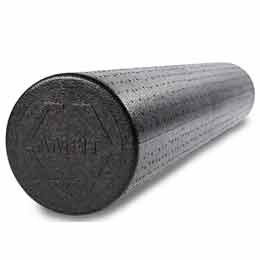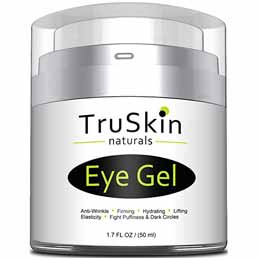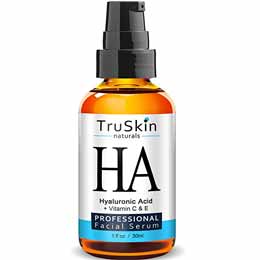How to Make Homemade Geranium Oil
This infused oil came straight from my garden and into the jar. I love rose geraniums, they are pretty to look at and I love the rosy scent they have.
So, one day I decided I had to make my own rose geranium oil and it turned out great! I love the lightly scented geranium oil.
I have read where some people haven't had much success with their infused oils of scented geraniums, maybe they didn't use the right plant as there are a variety of them? Mine turned out awesome!
Not all geraniums have a scent, so if you're thinking of growing your own for making oils or just enjoying them because they are beautiful and smell nice, be sure when your picking out the plant you're thinking of buying - you lightly rub the leaves between your fingers or just brush up against the plant. This action will release the scent instantly and you can't miss that wonderful smell. I have read that the older, yellowing leaves will have a stronger rose scent, and they do but either way - young leaves or old, you'll know right off the bat if it's actually a scented geranium.
So, let's get on with learning how to make geranium oil?
Making and Preparing Your Rose Geranium Oil
Keep on reading and in 8 easy steps you're on your way to having a wonderful homemade oil.
Step 1 - Gather the Plant Material
Gather up all the plant material, flower, leaves, stems, etc. The leaves actually have the most fragrance and stems are pretty fragrant themselves. I pick mine in the morning when there is a slight dew everywhere. Before I bring them in the house I gently shake them off.
Step 2 - Let Your Clippings Wilt
Bring them in the house and place them on a towel for the day so they can loose moisture and wilt a bit. If you are unsure, wait until the next morning to prepare your infusion.
Do not infuse your oil with plants that are wet or not dry enough, this could cause mold to grow in your infused oil and if this happens, you'll have to dump it out and start over.
Step 3 - Fill Your Jar with Geranium Clippings
When ready, chop the leaves, flowers, and stems and place them in your glass jar. After cutting the geraniums in smaller pieces, I actually bruise them gently by rubbing them between the palm of my hands to help release some of the scent before adding the oil. The size jar you use will be dependent on how much infused oil you want.
For the picture I didn't quite fill the jar with enough oil. When you make yours, add just a bit more (almost under the mouth of the jar or below where the bottom of the lid sits). This way you leave a little room for movement when you give it it's daily shake.
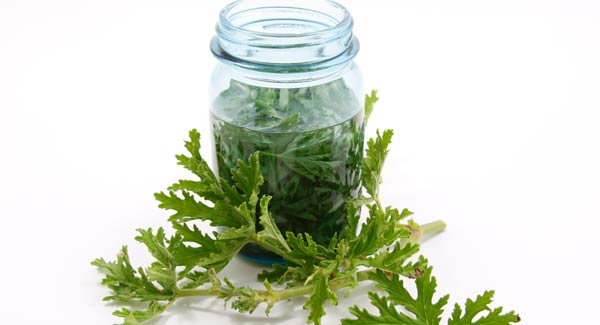
Step 4 - Add Your Oil of Choice
When you have filled the jar with the plant material, fill it with the oil of your choice. Fill it just a bit over the plant material. Here is an article (this link will open in a new tab so you can easily get back to this article) and down around the middle it talks about different types of carrier oils that you might choose to use.
I typically use Extra Virgin Olive Oil or Almond Oil when I infuse oils but olive oil can leave behind a touch of what it smells like, which is not bad, but I wanted to make sure the scent of the rose geranium came through so I used Fractionated Coconut Oil which doesn't have the smell of coconut.
Step 5 - Seal the Jar and Find a Warm Place
Put an airtight lid on your jar and place it somewhere where it isn’t too cold. You can place it next to a warm kitchen window or the kitchen counter or similar.
Maybe even the shelf in a closet where sunlight is filtered in. I work from home and so I leave mine in the office where I know I won't forget about my oils.
Step 6 - For 4 to 6 Weeks Give a Little Shake Each Day
Now every couple of days you'll give the jar little shake or swirl each day. Nothing much, just enough to move the contents around. You will do this for 4 to 6 weeks.
Step 6a - Stir the Contents
One thing I do every few days is to open the container and use a wooden or plastic spoon to stir the contents and lightly smash the plant material to help release the scent. If you do this, make sure when you to wipe around the edges of the lid and make sure there is no oil and you're getting a tight seal.
I know, it's seems like a long time but it really isn't, you'll be happy with the end results.
Note: The second time I made my geranium oil, every two weeks I strained the oil and added new plant material just to see if I got a more rosy scent. I think maybe just a little more scent but I did like the idea of adding new and fresh plant material.
Step 7 - Time to Strain the Oil
When it's time to strain the oil, place a piece of double layered cheesecloth over a funnel and slowly start pouring the oil through into a bowl.
When you get to the end of pouring the oil, grab up the cheesecloth with all the plant material in it and squeeze out as much of the geranium oil as you can then discard the leaves, flowers, and stem pieces.
If necessary, use a new piece of cheesecloth and strain again to make sure all plant material is gone.
Note: If you're like me and you want all the oil you can possibly get, after squeezing the life out of the plant material, you may notice swirls of a dark color in the oil. This has been common for me and I think it's just part of the plant material. What I do when I'm ready to put the final product in my container is to put the funnel on the jar and put a double layer of paper towel in the funnel. Then pour the oil in and the paper towel will catch the debris and you're left with a clear oil.
Step 8 - Using Your Geranium Infused Oil
Now you can pour your oil into a clean jar and use it as you will. Yeah! Make sure to use an airtight lid, keep it stored in a cool place, dark place and label the jar with what's in it and the date.
This should keep just fine for 6 months to a year if stored properly.
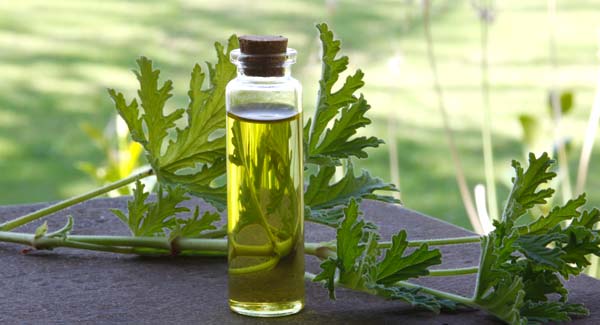
How I Use My Natural and Homemade Geranium Oil
I don't want to contaminate my oils so I will typically pour my infused oils into smaller containers. Because our fingers have oils on them, I will pour a little on my fingers vs putting a finger over the opening of the bottle or I'll use a dropper that only goes in this oil.
I use my geranium oil straight as it was made and use it on my face, neck, chest area (it's kind of like a perfume). I love that it's completely natural, no other ingredients but the plant material and the oil of my choice. Geranium oil has anti-fungal and antibacterial properties and said it can help treat wounds and promote healing and help to prevent infection.
Although I haven't used it for this purpose, Geranium oil is also good for treating skin conditions, like acne and eczema. I've made an all natural DIY Facial Cream (yummy) and I'll be making some Homemade Soap using my Geranium Oil.
I also have some of my Geranium Oil mixed with a little Argan Oil that I use on my face before going to bed. It makes it feel so soft and I think it makes my face look fresh. Again, I love it.
Another way I use it is when I get out of the shower I spritz my face with the Aloe Vera Spritzer I make, when that dries I put on my Geranium Oil and let that soak in a bit, then I add my moisturizing products. What I really like about this - when I go out and walk my dog and there is a breeze, I smell the rose, it's so nice.
I just have to say again how happy I am with my homemade geranium oil. It really does leave my skin feeling silky smooth.
Have you tried making this oil? Do you have a favorite oil and plant material you like to infuse?
Homemade Recipe Tips
- Make sure your work space and hands are clean.
- Make sure the containers you are using are clean.
- Make sure salves and creams have cooled enough before pouring in glass containers so they don't break.
- Keep the batch size small so the homemade products you use are fresh unless you're making gifts.
Infusing Herbal Oils
- Before you decide on which plant material you are going to use, I recommend you do your research on the plants or herbs you want to use.
- The infused oils I make are for topical use, I recommend you do a little test on your skin prior to using your infusion, just to make sure you don’t have a reaction, chances are pretty low that it would bother you, but you just never know especially if you have sensitive skin.
- All my infused oils have turned out great for the salves I’ve made or using them as they are or mixing with other oils and essential oils.
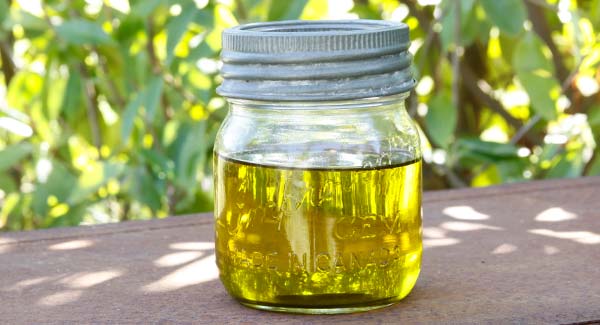

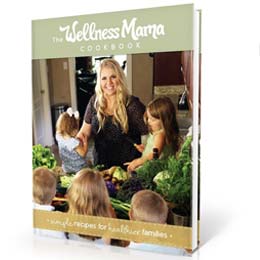

 Wellness Mama 5 Step Lifestyle Detox
Wellness Mama 5 Step Lifestyle Detox